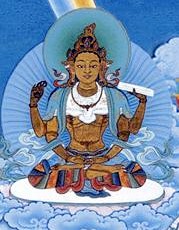Prajnaparamita: Difference between revisions
Jump to navigation
Jump to search
mNo edit summary |
No edit summary |
||
| Line 24: | Line 24: | ||
==External Links== | ==External Links== | ||
*[http://www.lotsawahouse.org/prajnaparamita.html Prajnaparamita Series on Lotsawa House] | *[http://www.lotsawahouse.org/prajnaparamita.html Prajnaparamita Series on Lotsawa House] | ||
*[http://www.himalayanart.org/pages/prajna/index.html Prajnaparamita (deity) outline page at Himalayan Art] | |||
[[Category:Key Terms]] | [[Category:Key Terms]] | ||
[[Category:Buddhas and Deities]] | [[Category:Buddhas and Deities]] | ||
[[Category:Prajnaparamita]] | [[Category:Prajnaparamita]] | ||
Revision as of 10:20, 23 July 2009

Prajñaparamita (Skt. Prajñāpāramitā; Tib. sherchin; wyl. sher phyin) – literally, ‘transcendent wisdom’.
- the sixth of the paramitas: perfect non-conceptual wisdom.
- the class of Buddhist literature that was mainly discovered by Nagarjuna in the second century. Its central topic is emptiness.
- the female deity who is the embodiment of transcendent wisdom.
Definition
"Prajnaparamita is the wisdom of directly realizing the non-conceptual simplicity of all phenomena, which has arrived at, or will lead one to, non-abiding nirvana."[1]
Subdivisions
According to the teachings of the Abhisamayalankara, there are four subdivisions:
- natural prajnaparamita
- scriptural prajnaparamita
- path prajnaparamita
- resultant prajnaparamita
Literature
Notes
- ↑ From The Words of Jikme Chökyi Wangpo by Khenpo Tsöndrü.